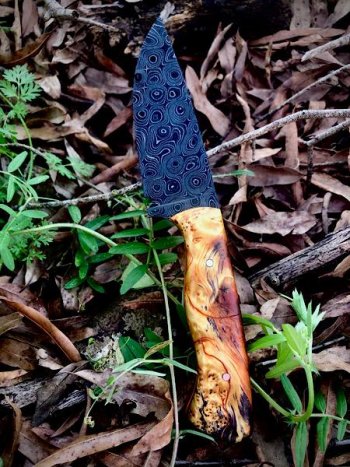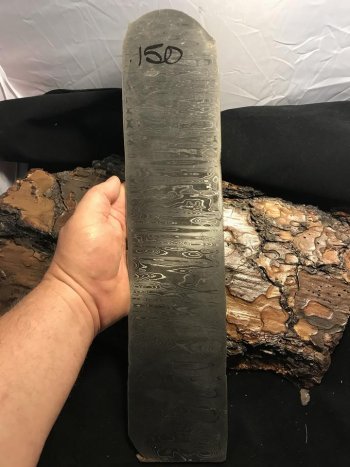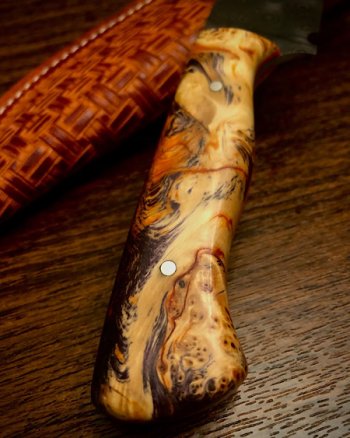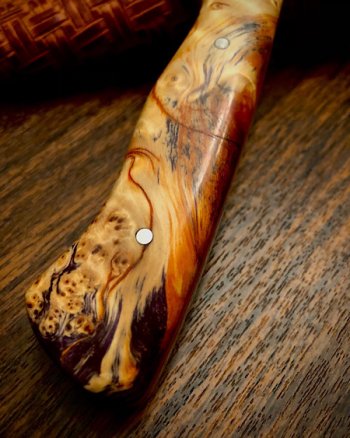You are using an out of date browser. It may not display this or other websites correctly.
You should upgrade or use an alternative browser.
You should upgrade or use an alternative browser.
Ferric Formula
- Thread starter Randy Lucius
- Start date
Chris Railey
Well-Known Member
What do you mean? Like a blacksmith club?just charges a monthly fee.
Chris Railey
Well-Known Member
I have often thought their mix to be strange as well. The nickel is what gives their steel its look because the rest etches very dark. With 15N20 layered with 5160 and nickel 200 I would expect to see very dark layers with kind of dark layers and a few shiny layers. In reality, you get very dark layers and shiny layers. I am not saying they are doing anything wrong but I have always found it curious. I have used several pieces of their steel and never had a problem with it. In line with what John said though, I have not done any real hardcore testing on it either.That's an interesting mix of steels they use for their Damascus. Seems like some of them might not play too nice as far as heat treating goes. And one of those steels is a non hardening low to no carbon steel.
Adam Pound
Well-Known Member
Really nice!If you like your Damascus black (and I do). Try this. I had been using a 3:1 mix of distilled water and ferric. Then doing a coffee etch to get it black. This was done with 45% distilled water, 45% ferric and 10% apple cider vinegar. I really like it.
View attachment 78420
chrisstaniar
Well-Known Member
What do you mean? Like a blacksmith club?
Kinda, it's actually a pretty big place that does lots of different stuff and they have a forge area with all the standard stuff. But then they also have some of the bigger hydraulic types of equipment. I need to do the "tour" so I can see what they have.
Bruce McLeish
Well-Known Member
where is this? Nevada city? I may need a road trip!
chrisstaniar
Well-Known Member
That's an interesting mix of steels they use for their Damascus. Seems like some of them might not play too nice as far as heat treating goes. And one of those steels is a non hardening low to no carbon steel.
Not to hijack the thread (Sorry).
Their combo's seem to vary from billet to billet.
where is this? Nevada city? I may need a road trip!
Yes, it's called "The Curious Forge". It's an "artsy" kinda place but they have a forge area.
chrisstaniar
Well-Known Member
chrisstaniar
Well-Known Member
Resurrecting this thread. @Randy Lucius, if you don't mind, what is your process for ferric chloride and then the coffee etch? I saw the ratios but was wondering about how many times in the ferric? Sanding? how strong is the coffee?
thanks!
thanks!
Randy Lucius
Well-Known Member
Hi chrisstanair! I've recently changed my process on etching Damascus. I use 45% ferric, 45% distilled water and 10% vinegar. Let it soak for five to ten minutes. Rinse it while gently scrubbing with a soft bristle tooth brush. Repeat this as many times as you like until you get the depth that you like. On the last etch do not scrub. Rinse with windex and use a heat gun to dry it. Hit it with some WD40 and dry it off good. I then like to use Wolf Premium oil on it. It's some great stuff! If you're doing a coffee etch the process is the same. You can use your ferric ratio. The coffee needs to be as concentrated as you can get it. Use as little water as possible to dissolve it. If you use the other process I believe you will prefer it over the coffee etch. Hope this has helped some.Resurrecting this thread. @Randy Lucius, if you don't mind, what is your process for ferric chloride and then the coffee etch? I saw the ratios but was wondering about how many times in the ferric? Sanding? how strong is the coffee?
thanks!

chrisstaniar
Well-Known Member
Hi chrisstanair! I've recently changed my process on etching Damascus. I use 45% ferric, 45% distilled water and 10% vinegar. Let it soak for five to ten minutes. Rinse it while gently scrubbing with a soft bristle tooth brush. Repeat this as many times as you like until you get the depth that you like. On the last etch do not scrub. Rinse with windex and use a heat gun to dry it. Hit it with some WD40 and dry it off good. I then like to use Wolf Premium oil on it. It's some great stuff! If you're doing a coffee etch the process is the same. You can use your ferric ratio. The coffee needs to be as concentrated as you can get it. Use as little water as possible to dissolve it. If you use the other process I believe you will prefer it over the coffee etch. Hope this has helped some.
View attachment 80504
Ok gotcha, thanks!
So the black coloring can result from the ferric alone and isn't in addition to a coffee etch?
Mister Coffee
Well-Known Member
Not to change the subject... but, what type of wood did you use for than handle? That's a good lookin' knife.
I'm with Fordie. It's an amazing knife, but I'd like to know more about that wood.
Randy Lucius
Well-Known Member
Randy Lucius
Well-Known Member
Correct.Ok gotcha, thanks!
So the black coloring can result from the ferric alone and isn't in addition to a coffee etch?



